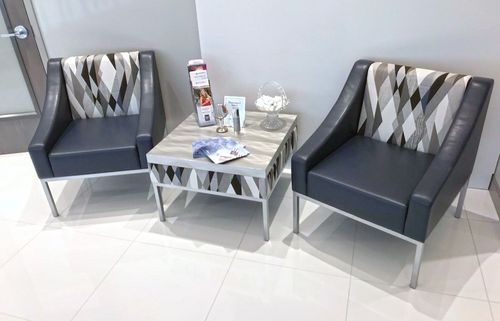Enhancing Patient Experience with Thoughtful Design
Healthcare facilities are transforming their approach to interior design. The sterile, institutional look of traditional medical furniture is being replaced with stylish, functional pieces that are more comfortable and inviting. To achieve this, many hospitals and medical offices are turning to high-end commercial furniture manufacturers that typically cater to luxury hotels, upscale restaurants and corporate spaces.
One company at the forefront of this shift is Modern Line Furniture, a renowned name in commercial furnishings. Their American-made designs, once exclusive to venues like the Ritz Carlton and World Trade Center, are now elevating the look and feel of medical facilities nationwide.
Bridging the Gap Between Style and Medical Standards
Vlad Spivak, owner of Modern Line Furniture, has seen a significant uptick in healthcare sector inquiries.
“We have been getting a lot of calls from medical facilities,” Spivak shares. “It’s exciting to apply our hospitality industry knowledge and experience to healthcare spaces, where both aesthetics and functionality are critical.”
The shift toward upscale furniture is driven by the desire to create a welcoming atmosphere that enhances the patient experience. Bobby Shuster, of Sunrise Medical Center, explains why his facility chose to work with a high-end furniture manufacturer rather than a traditional medical supplier.
“Sunrise Medical Center chose Modern Line Furniture because we were looking for stylish yet functional options that could meet the unique demands of a medical environment.”
Prioritizing Hygiene, Durability, and Comfort

While aesthetics are important, medical furniture must also meet stringent industry requirements for hygiene, durability and patient safety. Modern Line Furniture tailors its designs to address these critical aspects while ensuring an elevated look and feel.
Spivak highlights three key factors that influence their approach:
- Hygienic Materials: “Infection control is essential in medical environments,” Spivak explains. “We use waterproof vinyl and non-porous fabrics that do not absorb bacteria and are easy to sanitize, making them ideal for healthcare settings.”
- Structural Durability: “Medical furniture must withstand heavy use,” he continues. “Our seating solutions are built with reinforced frames and a 500 to 600 pound weight capacity, to ensure safety and longevity.”
- Optimized Functionality: “Beyond aesthetics, our furniture is designed for ergonomic comfort and practical use,” says Spivak. “For example, we enhance back support, integrate additional foam padding in armrests and incorporate features like built-in cup holders, paperwork trays, and charging ports to improve the overall patient experience.”
The Growing Influence of Interior Design in Healthcare
The integration of sophisticated interior design principles in medical facilities reflects a broader trend of patient-centered care. By moving away from stark, clinical furnishings and adopting contemporary colors, textures and forms, hospitals and clinics can create a more calming atmosphere that benefits both patients and staff.
Spivak emphasizes the importance of this shift. “Our experience designing for high-end restaurants, hotels and cruise lines gives us an edge in crafting furniture that combines luxury with practicality. Bringing these elements into healthcare settings enables us to elevate the patient experience while maintaining the necessary safety and durability standards.”
Research suggests that a well-designed medical environment can have tangible benefits. Thoughtfully arranged seating, for instance, can reduce stress and anxiety, making waiting times feel shorter and improving overall patient satisfaction. Additionally, ergonomic designs that provide ample support help provide comfort, especially welcomed by those who spend extended periods in waiting rooms or treatment areas.
Setting a New Standard for Medical Furnishings
As the demand for upscale yet practical medical furniture grows, companies like Modern Line Furniture are leading the charge in redefining the industry standard. The ability to merge durability, hygiene and aesthetics into a cohesive design is no small feat, but it’s a challenge they embrace.
“We’re proving that medical furniture doesn’t have to look cold and impersonal,” says Spivak. “Clients often come to us with inspiration images. We create custom medical furnishings that align with their vision while meeting industry requirements.”
This shift toward elevated design in healthcare spaces signifies a broader recognition of the role the environment plays in patient care. By prioritizing both function and form, medical facilities can foster a sense of comfort and well-being that ultimately enhances the overall healthcare experience.
To explore custom medical furniture solutions, visit www.ModernLineFurniture.com.





























